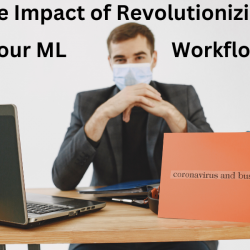How to Develop a Machine Learning Roadmap


Introduction
As the artificial intelligence industry is rapidly expanding and machine learning capabilities becoming more integrated into everyday life, you may be wondering how to develop a Machine Learning Roadmap. This blog will provide you with an introduction to ML concepts and terminology, discuss the ML lifecycle overview, outline the roadmap development process, and identify the benefits of having a roadmap. We’ll also discuss how to identify scope & resources and select tools & technologies, as well as some of the challenges associated with developing a road map.
The goal of developing a machine learning (ML) roadmap is to create a holistic plan that will achieve business objectives. The first step in this process is to gain an understanding of ML concepts and terminology. This includes topics such as supervised and unsupervised learning algorithms, neural networks, natural language processing (NLP), decision trees, reinforcement learning, clustering methods, etc. Once you have acquired knowledge about these concepts, it will be easier to move on with the roadmap development process.
Gaining an Understanding of ML Concepts and Technologies
ML concepts refer to the idea of using algorithms and statistical models to gain insights from data. They provide a powerful way to interpret and predict outcomes by generating valuable information from datasets. This concept allows machines and AI technologies to process large amounts of data quickly and accurately.
ML technologies refer to the hardware and software used in machine learning applications. This includes computer programs such as neural networks that can learn as they go along with new data or algorithms that can make predictions based on input provided. It also involves various techniques used for analyzing large datasets such as natural language processing (NLP), computer vision (CV), deep learning (DL), and reinforcement learning (RL).
Data science is an interdisciplinary field focused on using scientific methods, processes, algorithms, and systems to extract knowledge from structured and unstructured datasets. A strong understanding of data science is key for any aspiring ML engineer as it provides them with the tools needed for building complex ML models that can detect patterns in large amounts of data.
Knowledge base refers to a collection of information about a specific domain such as medical diagnosis or sales forecasting. Knowing how to create a suitable knowledge base will help ML engineers develop robust algorithms that can identify patterns within this data more accurately than humans alone could. Check Out:-Machine Learning Reviews
Setting your Goals
Once your goals have been clearly defined, you can go about defining the objectives necessary for their achievement. These could include things like data collection techniques, feature engineering techniques, and techniques for modeling and training. Then, make a plan for how you’ll implement these objectives—what resources and technologies do you need?
You’ll also need to set a timeline for when each task should be completed. Breaking down tasks into manageable chunks not only helps with time management but also ensures that each component of the project gets the necessary attention. Additionally, this step allows you to build your skill set to complete each task quickly and efficiently.
To stay on top of progress, consider setting up tracking mechanisms or check-ins with team members throughout the project. This will help keep everyone on track while ensuring that deadlines are met.
Choosing the Appropriate ML Approach
Once you have selected a strong ML architecture, it is necessary to assess its performance by testing out various scenarios. Monitoring how algorithms respond to changes will help ensure consistent accuracy and precision in results while incorporating feedback into predictive models helps to refine them further.
Creating a machine learning roadmap that suits your needs requires careful consideration and dedication. By evaluating data, choosing an appropriate model, optimizing hyperparameters, selecting an ML framework that meets your requirements, deciding on adequate infrastructure, and assessing algorithm performance, you will be one step closer to building an effective roadmap that produces the desired outcomes. Additionally, monitoring and incorporating changes into predictive models helps keep them up to date so that they can continue delivering accurate results over time.
Determining Data Availability and Quality
Creating a successful machine learning (ML) roadmap requires careful consideration of data availability and quality. By determining the sources and forms of data available, you can ensure accurate and consistent results. As part of your ML roadmap, it is important to understand the business needs and goals that will be addressed through your ML application. Additionally, digital resources and research can help inform your decisions while being aware of potential confidentiality issues with data sets should always be taken into account when developing an ML roadmap.
To determine the availability and quality of data, begin by surveying what digital resources are available for use in your project. This includes gathering datasets from internal systems, external sources, or public databases like Kaggle or UC Irvine’s Machine Learning Repository for educational use. It is important to identify the format of each dataset so that you have compatibility between each type. Once the sources have been identified, testing for accuracy and consistency should be done to ensure that the data is suitable for use in your application. When validating any datasets you should inspect elements such as record counts, outliers, missing values, date fields, etc., to make sure the quality of information meets expectations and can be used reliably in an ML algorithm. Check Out:-Data Science Reviews
Establishing a Feasible Timeline for Development
When developing a machine learning roadmap, it is essential to ensure that you have a feasible timeline for development. It is important to assess your capability, define goals, plan milestones, allocate resources, and estimate the cost and schedule before starting. Establishing an iterative approach will also help you keep track of progress and revise your plan accordingly. Finally, it is important to evaluate the results of your efforts to ensure that you are on the right track.
The first step in creating a successful machine learning roadmap is to assess your capability and determine what tools, techniques, processes, and resources you have at your disposal. This will lay the groundwork for the rest of the process by establishing what tasks need to be completed to achieve success.
The second step is to identify goals and create milestones that allow you to establish short-term objectives as well as long-term objectives. While this may seem overwhelming at first, if done properly it can help guide each aspect of development and also give developers a clear path forward.
Creating a Talent Pool & Building Internal Expertise
Creating a talent pool and building internal expertise are critical when it comes to developing a successful machine-learning roadmap. By identifying the areas of expertise within your team, you can begin to develop the skill set necessary for long-term success.
The first step in creating a talent pool is to identify the existing expertise within your organization. This can be done by evaluating individual roles and researching relevant subject matter expertise. Once identified, you can begin to collaborate with these experts to develop an understanding of the machine learning concepts and their potential applications for your company.
Another important part of creating a successful talent pool is to establish a knowledge-sharing platform. This will help ensure that everyone can access up-to-date information regarding best practices and new developments in machine learning technology. Utilizing resources such as blogs, webinars, and online courses can help further enhance the skill set of your team.
Considerations for Algorithms, Models & Frameworks
First, let’s consider algorithms. Algorithms are mathematical methods to identify patterns and extract useful information from data sources. Depending on which type of problem you are trying to solve, different types of algorithms may be more suitable than others. It is important to research and understand which algorithm(s) will best fit your needs before beginning development.
Second, models are necessary when building out a successful machine-learning roadmap. Models use algorithmic techniques with training data from data sets to make predictions about new data points based on what it has learned before. To ensure accuracy and reliability with predictions, it is crucial to use high-quality models that were carefully built and refined using appropriate techniques.
Thirdly, frameworks should be explored when developing a successful machine-learning roadmap. Frameworks are powerful tools that help organize the model-building process by providing guidelines for creating efficient models and reducing development time. Commonly used frameworks include TensorFlow and Keras–it helps save time when tackling complex problems by allowing developers to focus on the specific task at hand rather than starting from scratch every time they need to build something new. Check Out:-AI reviews
Implementing an Effective Machine Learning Roadmap
The first step in developing an effective machine learning roadmap is to understand your goals. What do you hope to achieve by implementing machine learning? Are you looking to increase the efficiency or accuracy of your processes? Do you want to gain insights into customer behavior? Pinpointing your objectives will help inform other decisions for creating your roadmap.
Next, outline the scope of your project. This step involves identifying how far-reaching the project should be as well as which teams, individuals, and/or departments will be involved at various stages in the execution of the project. Identifying the resources and roles upfront can help streamline workflows and improve collaboration across teams.
Once you have a clear understanding of your goals and scope, it’s time to gather relevant data for training purposes. This includes any data collected by different departments such as customer feedback, financial records, or product performance metrics that apply to the project objectives. With enough data points, your team can identify patterns that can be utilized in setting up a powerful machine-learning algorithm later in the process. Check Out:-Reviews






Ingen kommentarer endnu